Help Identifying Fungi and Plants as potential Wild Food
I get a lot of requests online for help identifying wild foods – especially fungi. I generally welcome these – it is a pleasure to help people improve their knowledge and gives me an opportunity to sharpen my identification skills. Win-win. But I feel a little guidance to people looking for help with ID would make the exchange more useful to both them and me. So here are a series of guidelines on to how best to frame enquiries.

Please note that if I have directed you here, I am not necessarily suggesting that you have made all the mistakes outlined below, so please draw the lessons that are relevant to your particular enquiry, and try again!
I am often inundated with questions and identification queries, and while I do try to answer as many as possible that meet the basic guidelines around manners etc outlined below, my time is finite. So if you are looking for my time, please consider booking me for a 1-to-1 online mentoring session. These allow us to drill a bit deeper into ID, and more nuanced things like edibility, sustainable harvesting, recipe ideas etc, and have proven very useful to a lot of people, not only with individual ID queries, but also in helping them develop their personal ID skills – a bit like teaching someone to fish, rather than giving them a fish! Its a great way to learn.
Its easiest to start with a genuine example of exactly how NOT to ask for help identifying something. This is an extreme example, but it is the easiest way to point out some of the difficulties. I will mostly refer here to the identification of fungi, but most of the lessons are transferable to plants. This example was sent as a Tweet, but I have received many similar on this website, facebook and by email. (I have changed the pictures for convenience).
“Are any of these edible?”
I’m hope you will see immediately a few ways in which this isn’t a great way of asking somebody you’ve never met for advice on a potentially life and death matter!
1. Manners!
Pls or thnx don’t take up that much space, even if you are restricted to a tweet. Many people do ask in a friendly and polite manner – so if i’ve sent you here, please don’t assume its because I think you’ve been rude. But a surprising number of enquirers seem to expect a fungi identification robot! An even ruder version, which I regularly receive, begins “Before I kill myself eating this…”. So not only are they thrusting themselves into my inbox, but they are attempting to place some responsibility on me for their safety. Perhaps its an attempt at humour, but its an extremely poorly judged one. Which brings me to my second point…
2. Edibility.
In this example enquirer doesn’t seem to be interested in what species the fungi are. I once had such an enquiry from somebody who referred to themselves as a “gourmet”! How undescerning can you get!? Again, my example may seem extreme, but at least a third of the ID enquiries I get ask only if the pictured plant/mushroom is edible – not what it actually is, or if it is worth eating.
Sand, grass and even McDonalds burgers are technically edible. Wild plants and fungi can range from deadly to delicious, but the vast majority fall somewhere between, and edibility is rarely black and white. Check out my blog on The Spectrum of Edibility.
The implication seems to be that the enquirer has no interest whatsoever in the plant or mushroom if it is inedible. This is a really good way of alienating the person who has presumably taken a good deal of time and effort getting to know their subject.
Worse than this, I regularly get sent pictures of large quantities of fungi that people have picked with no idea whatsoever what species it is. For all they know they could be incredibly rare, highly poisonous, or both. Even if the species turns out to be common or edible, it is still a rather thoughtless way of going about your business. One or two specimens, properly photographed (see below for how to take useful ID photos), with habitat information, is all that is required to attempt an identification.
Most importantly of all, it is, at best unfair, at worst complete foolishness, to ask a stranger whether you should eat something. There have been several cases of online misidentification by knowledgeable and well-meaning experts that have lead to acute poisoning and even death. Many fungi forums have banned discussions on edibility. I don’t visit any of the plethora of Wild Food Facebook Groups that have sprung up in the last few years because the quality of both enquiries and answers are frighteningly low and those offering their (often inaccurately guessed, but very confidently given) ID can often get quite stroppy if I suggest they may not be correct.
Where folk ask for help on my own platforms, my policy is to offer my thoughts only on the identity of the plant or mushroom:
It is for the individual to decide whether to (a) agree with the identification and (b) proceed to eat the item.
Even when identity is established and edibility ascertained, there are still a great many wild foods – fungi especially – that are generally edible, but cause an adverse reaction in some people. (This is true of almost any new food – not just wild foods!). You can only find out if a new food is for you by eating a small quantity of the specimen, well cooked and on its own, then waiting for a few hours. This puts a lot of people off and that’s fair enough. Personally I feel the possibility of an hour or two’s mild gastric discomfort is a small price to pay for a delicious new wild food on the menu!
In asking someone whether a wild species is edible, the answer may often be more nuanced than a simple “yes” or “no”. So you are asking them for a judgement call that they often can’t reasonably make without knowing more about you, and spending a lot of time and effort trying to convey the nuances of their insight.
Foraging is about taking personal responsibility for what you eat. Use any steers you might get as a starting point for your own research, not a definitive answer.
Wood blewits, shaggy parasols and clouded agaric – three common and tasty mushrooms that cause a tummy upset in some people
3. Laziness.
In my example, the enquirer may well have spent sleepless nights poring over identification guides, struggling with their limited experience before finally looking for outside help. But the message shows no evidence of that. It looks rather more like they have pointed their camera phone at a few things that have caught their eye then sent it for diagnosis without really going to any trouble. There are some pretty good website ID guides a click away for those that wish to invest some time in finding out what they have stumbled upon.
Plant and Fungi Identification Apps are becoming more widely available. Most struggle for accuracy, and are generally dreadful at identifying mushrooms, but perhaps they can be a helpful tool to give you some ideas for further research. Never eat a plant or mushroom based on an ID Apps opinion, still less on an internet image search – this is asking for trouble.
Read my exploration of the Pros and Cons of Plant and Fungi ID Apps
This is why I suggest that ID enquiries include a “best guess” – even by complete novices. Identification skills only improve by honing observation skills and investing some meaningful time.
4. Taking Useful ID Photographs

Asking for an identification of a mushroom based on just a shot of the top of the cap is directly comparable to asking for identification of a human from a “top-of-the-head” shot! Asking for edibility advice based on a cap shot is like asking if you should buy a house with, or marry, someone based on a “top-of-the-head” shot!
You wouldn’t expect a doctor to diagnose your illness by just letting them look at the top of your head. In the same way, it is very difficult – often impossible – to identify a plant or fungi with just a picture of its leaf or cap.
Fungi can be particularly challenging. On a foray with a professional mycologist, at least a third of the species we found could only be definitively identified with a microscope. Even with a mushroom in hand or an excellent set of pictures it is often only possible to say which genus a mushroom may be part of. Accurate ID in the field often requires smells, textures and even taste – none of which can be conveyed in one photo (which is why ID apps are so often inaccurate). So do please manage your expectations!
For the person attempting to help to have a realistic chance of giving you any more than a guess, try to ensure your picture includes as much as possible of the following:
- Scale – place a knife, coin, hand, person etc in the picture
- Fungi: cap from above
- Plants: leaf lying on a flat, contrasting surface
- Fungi: cap from below – this may require picking a mushroom and placing it upside down beside growing specimens
- Plants: Examples of flowering stems, buds, leaf stems, flowers, seeds etc – depending in what stage the plant is at.
- Fungi: Cross-section through cap and stipe if possible
- Focus – please do your best to make sure the picture is reasonably well defined. Cameras can struggle to focus on small leaves, flowers etc, but by placing your hand immediately behind them, you can get them in focus
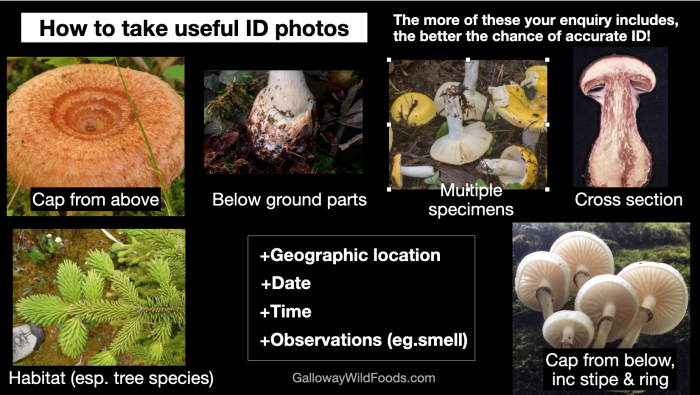
To receive a meaningful, useful reply, an ID request should include as much as possible of this information
Further observations on smell, nearby trees, geographic location, time of year the image was taken etc can also greatly help in attempting a meaningful identification.
If its not possible or practical to assemble all these images and information, one good photo including as much as possible might be useful. Here are some examples of fairly useful ID pictures:
5. Habitat and location
The more information you can include, the better. The specific habitat in which the mystery species is growing can be an important clue to its identity. In the case of many mushrooms the host or partner organism (often a specific species of tree) is essential for accurate identification. Remember that a tree’s roots reach as far out from its trunk below ground as its branches do above ground.
General habitat is also important – was the plant/mushroom growing coastally? On flooded ground? On bare soil?
Geographic location can also help to eliminate certain species – eg. Scots Lovage doesn’t grow in S England, Alexanders are rare in Scotland etc.
I hope this article does not dissuade anyone from asking me (or anyone else) for help with plant or mushroom identification. I hope it does help people to frame their requests in a more useful way – for themselves and the person they are asking for help from.
Here are some examples of good ID help pictures and accompanying requests (all in under 150 characters!):
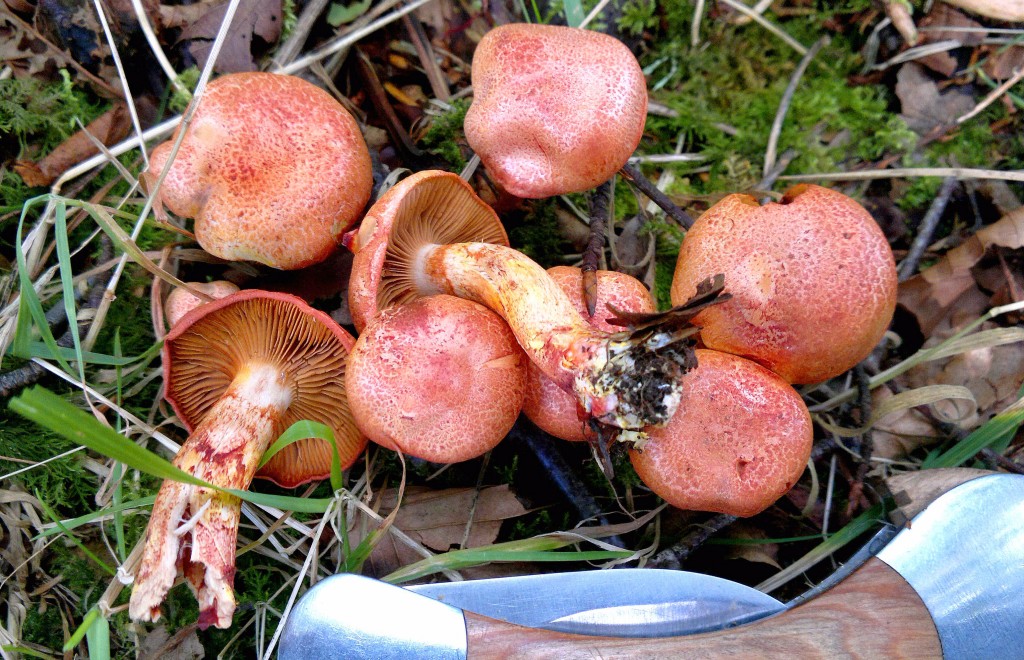
Please could you help: lots of these in damp beech woods near Keswick. Think they may be a type of webcap?
These turned out to be blushing bracket (probably!), cortinarius bolaris (poisonous!), and greater cuckoo flower (now one of my favourite salad greens!). All these were pictures I took myself and puzzled over before asking for help.
Here are some more posts to help you get to grips with identifying potential wild foods:
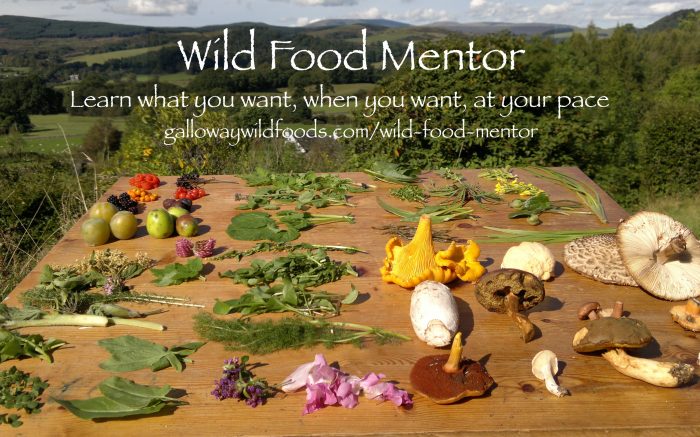
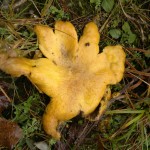
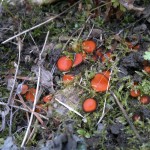
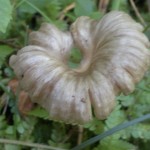
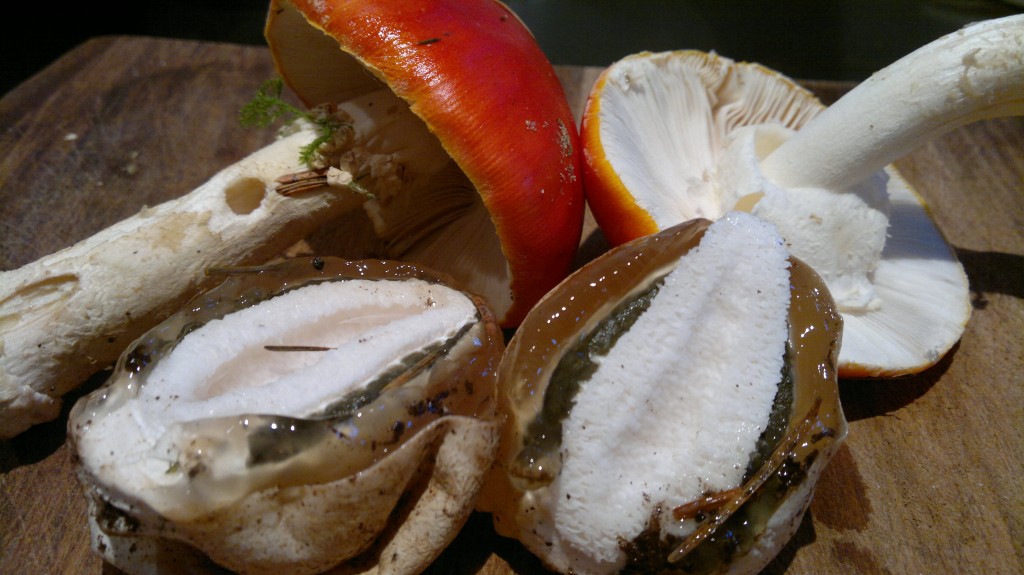
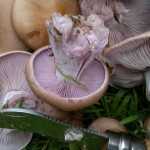
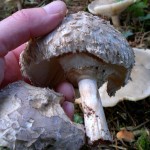
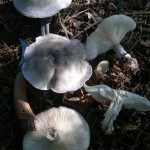
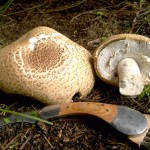
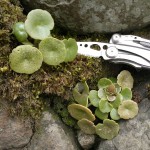
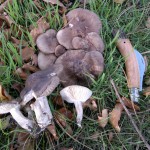
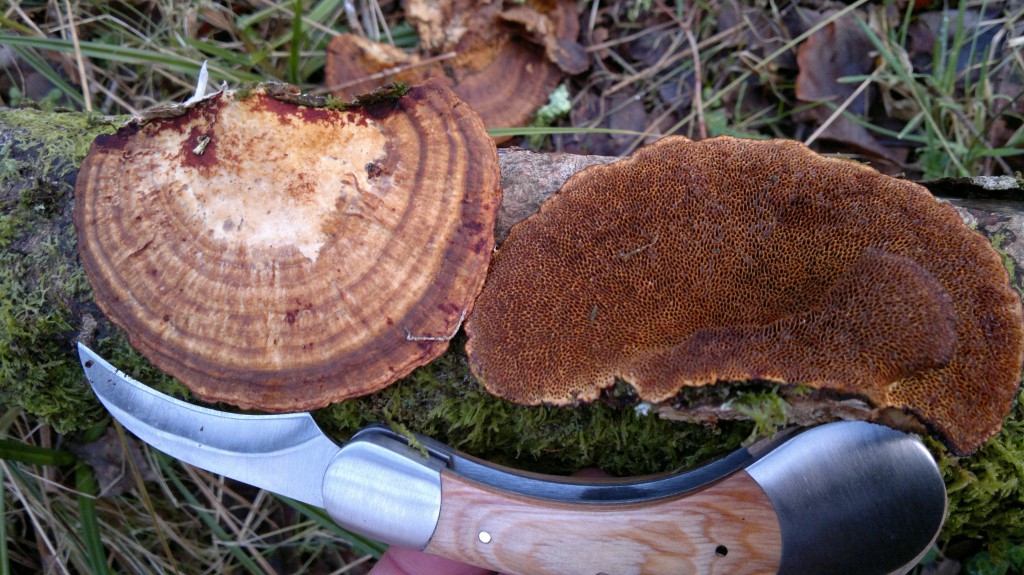
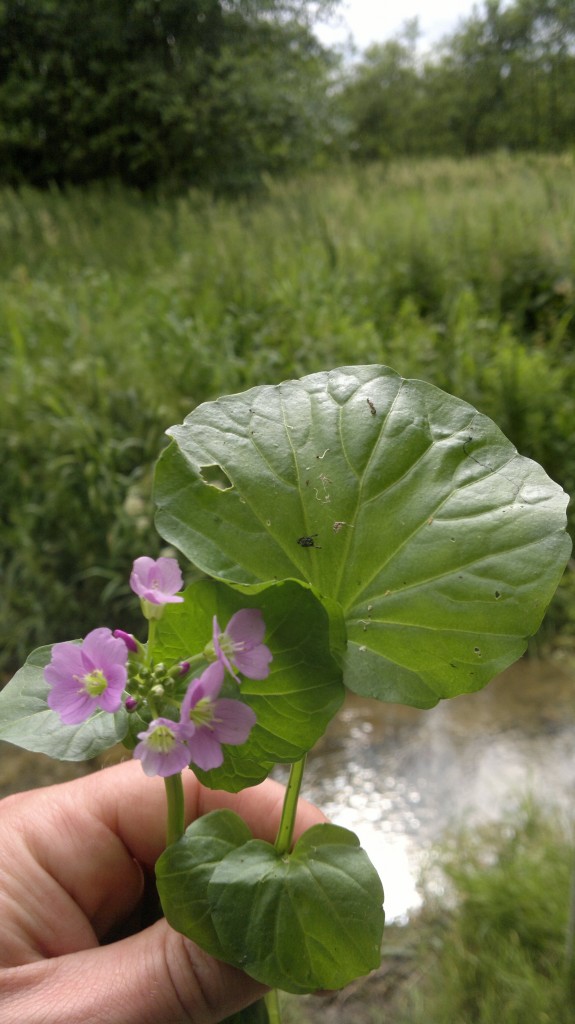
17 Comments
“You wouldn’t expect a doctor to diagnose your illness by just letting them look at the top of your head.” HA HA HA!!!
Great post!
Thanks Fergus, please feel free to direct any “incomplete” ID requests you get here! And thanks for your inspirational website – love your work. You seem to have been a bit quiet on it for a while – hope all is OK?
The brown bracket fungus is a blushing bracket or Daedaleopsis confragosa
Sand, grass and even mcdonalds are technically edible, ha ha ha, that tickled mi
Hi Mark
Hope you are well. It’s been a while since we last met in Bargaly Woods, Palnure! We still run courses overthere and also -new- in the cairngorms. That’s where we found a tourist brochure with an article from you in it about collecting mushrooms in the Cairngorms! Small world. Could you help us out with following: there is a shop (?) which sells deer you told us, somewhere near Carsluith, is it? Do you have their address, as we would like to get in touch with them. We allways try to buy a deer from the Forestry, but not allways successfull, in this way we hope to have an extra contact to get meat on the table! Thanks beforehand, René Nauta – Holland
Hi Rene,
Just picked this up – replied to your email.
Cheers,
Mark.
Hi,so pleased found this site..I live in Rochdale Lancashire where I play golf.Lots of fungi about,But i’ve no idea. Excelent pics & advice.After looking at this site I Thought I’d found;”horse M/rm” near Pines &Conifers wrong month! Field/flat M/rm still checking.Going to do the 2hr bad tummy test.!!
Do you do field classes for the uninitiated .Cheers Edd
Thanks Eddy. A whole wide world of discovery awaits…!
I think you have found my events page, and private bookings page.
Cheers,
Mark
Hi Mark – Great site, helpful tips and useful photos – thanks for all of these. Can you help on a tree question? There is contradictory online advice about sycamore seeds. The trees are common, have abundant “keys” in the autumn and are easy to identify. Some sites say the seeds are edible, while equine sites connect horses eating them to fatal heart disease (atypical myopathy). Other sites talk about tapping the sap, but ignore the keys. Any idea if the keys are safe or not? I haven’t eaten any on the precautionary principle! Thanks in anticipation.
Hi Jon,
Sorry, I have no experience of eating sycamore keys and haven’t heard of anyone eating them. I am very fond of ash keys, which are similar but may have quite a different make-up. I hear mentions of tapping sycamores, but never anyone reporting it being in any way worthwhile.
Cheers
Mark.
Hi Mark,
Just enjoyed listening to you on Radio 4’s Food Programme and followed up on the Internet. Will definitely be watching out for you in future as I enjoyed very much.
With reference to the the “good ID help pictures” above, could you please elaborate as to what the greater cuckoo flower is?
I don’t wish to be pedantic, and I am only a keen amateur myself but I haven’t hear of the “greater” cuckoo flower only the “cuckoo flower” Cardamine pratensis. I checked in a couple of my books and in particular Geoffrey Grigsons “The Englishman’s Flora” but could find nothing. It’s also possible that I’ve not heard of it because I live on the Isle of Man and perhaps we don’t have it here! Thanks in advance.
Grahame
Hi Grahame, Thanks for getting in touch – so glad you enjoyed the programme.
The plant is cardamine raphanifolia. You can read about it on my wild plant guide here: http://www.gallowaywildfoods.com/greater-cuckoo-flower-identification-distribution-edibility/
I made up “Greater Cuckoo Flower” as I couldn’t find a common name for it and it is closely related!
Cheers
Mark.
Hi Mark, I’ve only discovered your site this evening after a foraging trip in my local forest, Blairadam forest in East Fife, the forest is less than a minutes walk from my home. I still have my very first book given to me and child on Britain’s wildlife, plants, and flowers by Readers Digest which is still refer to too identify things but namely mushrooms since I am good at identifying other flora and fauna. I recently bought another book which is solely dedicated to mushrooms and toadstools amd, today on a walk I discovered what I’m 99% sure is Saffron ringless amanita. I collected one and have searched the ‘mushroom guid book’ and online which led me to your site. So glad I’ve found it and have signed up for your newsletter. The addition of recipes is a fantastic touch. Anyhoo, can you give me an email address so that I can ask you to confirm my identification please?
Just come across your site. As a complete beginner and having only been on a one day foraging course with Monica Wilde I wouldn’t dare eat anything I wasn’t 100% sure of. I came across what I know is a puffball species of mushroom this morning whilst our walking the dogs. I have picked a few and cleaned them but still unsure wether I should try them up and eat them. Mushroom quite rightly so makes me nervous. As you say even seasoned foragers have got it wrong! I will be back to read more from you I’m sure.
I’m wondering if immature, green tamarack pine cones can be used and infused in schnapps, etc. I cannot find information on their edibility, but I am assuming they fall into the edible pine category. The cones are awfully adorable and I cannot help but find myself gravitating towards them.
Yes, I don’t see why not. 🙂
Hello and thank you for this BRILLIANT post! I’ll be sharing it momentarily in several mushroom groups I’m a part of because it really answers so many questions for people of all levels looking for an ID. I feel like I’ve written many parts of this post myself in individual messages and DMs at one time or another ha ha! Great idea to have it all in one place.
Thank you for your hard work from a fellow forager from across the pond!